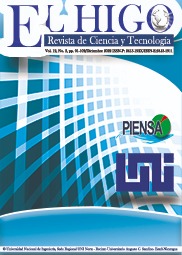Contaminantes presentes en granos y productos de cacao (THEOBROMA CACAO L.) a nivel mundial, una revisión
DOI:
https://doi.org/10.5377/elhigo.v12i2.15209Palabras clave:
Alimento, chocolate, inocuidad, metales pesados, micotoxinas, seguridad alimentarResumen
La Organización Mundial de la Salud [OMS] ha expresado su preocupación por la presencia de contaminantes en granos y productos de cacao, entre los que destacan los metales pesados y las micotoxinas. Debido a sus atributos potencialmente dañinos para la salud humana, se requieren medidas preventivas e intervencionistas apropiadas. Por lo tanto, el objetivo de este documento es sintetizar las últimas publicaciones relevantes de los contaminantes presentes en granos y productos de cacao a nivel mundial. Para tal fin, se realizó una revisión sistemática utilizando las bases de datos de la Universidad Nacional de Colombia mediante un análisis bibliométrico con dos componentes de búsqueda en inglés del 2012 al 2022 desglosado en metales pesados y micotoxinas en cacao. Adicionalmente se descargaron y analizaron las ultimas bases de datos (2002 al 2016) de la plataforma colaborativa de inocuidad de los alimentos [FOSCOLLAB] de la OMS. Las principales investigaciones en contaminantes de cacao se presentaron en Brasil con múltiples contribuciones y a nivel mundial destacan manuscritos de cadmio [Cd], plomo [Pb], arsénico [As], aflatoxinas [AFs] y ocratoxina A [OTA]. El análisis de las bases de datos de la OMS permite resaltar que los contaminantes presentes en los productos de cacao son de gran importancia en la calidad y consumo del alimento, se encontró al Cd como uno de los principales contaminantes en el producto y se destaca la presencia de Pb en la región europea, así como un aumento en el consumo del producto para el 2030, lo que genera una brecha importante en la investigación para la reducción de contaminantes en cacao.
Descargas
Citas
Abdel-Megeed, R. M. (2021). Probiotics: a Promising Generation of Heavy Metal Detoxification. Biological Trace Element Research, 199(6), 2406–2413. https://doi.org/10.1007/s12011-020-02350-1
Abt, E., Fong Sam, J., Patrick, G., & Posnick, L. (2018). Cadmium and lead in cocoa powder and chocolate products in the US Market. Food Additives & Contaminants, v. 11(2), 92-102–2018 v.11 no.2. https://doi.org/10.1080/19393210.2017.1420700
Amores, F., Butler, D., Ramos, G., Sukha, D., Espín, S., Gómez, A., Zambrano, A., Hollywood, N., Van Loon, E., & Seguine, E. (2007). Project to determine the physical, chemical and organoleptic parameters to differentiate between fine and bulk cocoa. Executive Committee - one hundred and thirty-forth meeting EBRD Offices, London. The International Cocoa Organization (ICCO).
Anyimah-Ackah, E., Ofosu, I. W., Lutterodt, H. E., & Darko, G. (2019). Exposures and risks of arsenic, cadmium, lead, and mercury in cocoa beans and cocoa-based foods: a systematic review. FOOD QUALITY AND SAFETY, 3(1), 1–8. https://doi.org/10.1093/fqsafe/fyy025 WE - Science Citation Index Expanded (SCI-EXPANDED)
Aria, M., & Cuccurullo, C. (2017). bibliometrix: An R-tool for comprehensive science mapping analysis. Journal of Informetrics, 11(4), 959–975. https://doi.org/https://doi.org/10.1016/j.joi.2017.08.007
Ayangbenro, A. S., & Babalola, O. O. (2017). A New Strategy for Heavy Metal Polluted Environments: A Review of Microbial Biosorbents. In International Journal of Environmental Research and Public Health (Vol. 14, Issue 1). https://doi.org/10.3390/ijerph14010094
Barghini, P., Esti, M., Pasqualetti, M., Silvi, S., Aquilanti, A., & Fenice, M. (2013). Inhibition of the ochratoxin-A producer Aspergillus carbonarius on withe and red grapes by crude cell-wall degrading enzymes from the antarctic fungus Lecanicillium muscarium CCFEE 5003. Journal of Environmental Protection and Ecology, 14(4), 1673–1679. http://hdl.handle.net/2067/35227
Barraza, F., Maurice, L., Uzu, G., Becerra, S., López, F., Ochoa-Herrera, V., Ruales, J., & Schreck, E. (2018). Distribution, contents and health risk assessment of metal(loid)s in small-scale farms in the Ecuadorian Amazon: An insight into impacts of oil activities. The Science of the Total Environment, 622–623, 106–120. https://doi.org/10.1016/j.scitotenv.2017.11.246
Beg, M. S., Ahmad, S., Jan, K., & Bashir, K. (2017). Status, supply chain and processing of cocoa - A review. Trends in Food Science & Technology, 66, 108–116. https://doi.org/https://doi.org/10.1016/j.tifs.2017.06.007
Bertoldi, D., Barbero, A., Camin, F., Caligiani, A., & Larcher, R. (2016). Multielemental fingerprinting and geographic traceability of Theobroma cacao beans and cocoa products. Food Control, 65, 46–53. https://doi.org/10.1016/j.foodcont.2016.01.013
Copetti, M. V, Iamanaka, B. T., Pitt, J. I., & Taniwaki, M. H. (2014). Fungi and mycotoxins in cocoa: From farm to chocolate. International Journal of Food Microbiology, 178, 13–20. https://doi.org/10.1016/j.ijfoodmicro.2014.02.023
De Oliveira, A. P. F., Milani, R. F., Efraim, P., Morgano, M. A., & Tfouni, S. A. V. (2021). Cd and Pb in cocoa beans: Occurrence and effects of chocolate processing. Food Control, 119. https://doi.org/10.1016/j.foodcont.2020.107455
Delgado-Ospina, J., Molina-Hernández, J. B., Chaves-López, C., Romanazzi, G., & Paparella, A. (2021). The Role of Fungi in the Cocoa Production Chain and the Challenge of Climate Change. In Journal of Fungi (Vol. 7, Issue 3). https://doi.org/10.3390/jof7030202
Delgado-Ospina, J., Molina-Hernandez, J. B., Viteritti, E., Maggio, F., Fernández-Daza, F. F., Sciarra, P., Serio, A., Rossi, C., Paparella, A., & Chaves-López, C. (2022). Advances in understanding the enzymatic potential and production of ochratoxin A of filamentous fungi isolated from cocoa fermented beans. Food Microbiology, 104, 103990. https://doi.org/https://doi.org/10.1016/j.fm.2022.103990
Eskola, M., Kos, G., Elliott, C. T., Hajšlová, J., Mayar, S., & Krska, R. (2020). Worldwide contamination of food-crops with mycotoxins: Validity of the widely cited ‘FAO estimate’ of 25%. Critical Reviews in Food Science and Nutrition, 60(16), 2773–2789. https://doi.org/10.1080/10408398.2019.1658570
International Cocoa Organization, I. (2022). Quarterly bulletin of cocoa statistics. International Cocoa Organization ICCO. vol. XLV, No. 4, Cocoa year 2021/22. https://www.icco.org/statistics/#production
Lippi, D. (2013). Chocolate in History: Food, Medicine, Medi-Food. In Nutrients (Vol. 5, Issue 5, pp. 1573–1584). https://doi.org/10.3390/nu5051573
Lo Dico, G. M., Galvano, F., Dugo, G., D’ascenzi, C., Macaluso, A., Vella, A., Giangrosso, G., Cammilleri, G., & Ferrantelli, V. (2018). Toxic metal levels in cocoa powder and chocolate by ICP-MS method after microwave-assisted digestion. Food Chemistry, 245, 1163–1168. https://doi.org/https://doi.org/10.1016/j.foodchem.2017.11.052
Maciel, L. F., Felício, A. L. de S. M., Miranda, L. C. R., Pires, T. C., Bispo, E. da S., & Hirooka, E. Y. (2018). Aflatoxins and ochratoxin A in different cocoa clones (Theobroma cacao L.) developed in the southern region of Bahia, Brazil. Food Additives & Contaminants. Part A, Chemistry, Analysis, Control, Exposure & Risk Assessment, 35(1), 134–143. https://doi.org/10.1080/19440049.2017.1397293
Maddela, N. R., Kakarla, D., García, L. C., Chakraborty, S., Venkateswarlu, K., & Megharaj, M. (2020). Cocoa-laden cadmium threatens human health and cacao economy: A critical view. Science of The Total Environment, 720, 137645. https://doi.org/https://doi.org/10.1016/j.scitotenv.2020.137645
Ostry, V., Malir, F., Dofkova, M., Skarkova, J., Pfohl-Leszkowicz, A., & Ruprich, J. (2015). Ochratoxin A Dietary Exposure of Ten Population Groups in the Czech Republic: Comparison with Data over the World. Toxins, 7(9), 3608–3635. https://doi.org/10.3390/toxins7093608
Pérez Moncada, U. A., Gómez, M. R., Serralde Ordoñez, D. P., Peñaranda Rolón, A. M., Wilches Ortiz, W. A., Ramírez, L., & Rengifo Estrada, G. A. (2019). Arbuscular mycorrhizal fungi (AMF) as a strategy to reduce the absorption of cadmium in cocoa (Theobroma cacao) plants. Terra Latinoamericana, 37(2), 121–130. https://doi.org/10.28940/terra.v37i2.479
Pires, P. N., Vargas, E. A., Gomes, M. B., Vieira, C. B. M., Santos, E. A. Dos, Bicalho, A. A. C., Silva, S. de C., Rezende, R. P., Oliveira, I. S. De, Luz, E. D. M. N., & Trovatti Uetanabaro, A. P. (2019). Aflatoxins and ochratoxin A: occurrence and contamination levels in cocoa beans from Brazil. Food Additives & Contaminants. Part A, Chemistry, Analysis, Control, Exposure & Risk Assessment, 36(5), 815–824. https://doi.org/10.1080/19440049.2019.1600749
R Core Team. (2020). R: A Language and Environment for Statistical Computing. R Foundation for Statistical Computing. https://www.r-project.org/
Romero-Estévez, D., Yánez-Jácome, G. S., Simbaña-Farinango, K., & Navarrete, H. (2019). Content and the relationship between cadmium, nickel, and lead concentrations in Ecuadorian cocoa beans from nine provinces. Food Control, v. 106, 106750--2019 v.106. https://doi.org/10.1016/j.foodcont.2019.106750
Sharma, R. K., & Archana, G. (2016). Cadmium minimization in food crops by cadmium resistant plant growth promoting rhizobacteria. Applied Soil Ecology, 107, 66–78. https://doi.org/https://doi.org/10.1016/j.apsoil.2016.05.009
Taniwaki, M. H., Pitt, J. I., Copetti, M. V, Teixeira, A. A., & Iamanaka, B. T. (2019). Understanding Mycotoxin Contamination Across the Food Chain in Brazil: Challenges and Opportunities. TOXINS, 11(7). https://doi.org/10.3390/toxins11070411 WE - Science Citation Index Expanded (SCI-EXPANDED)
Taqi, M., Rusydiana, A. S., Kustiningsih, N., & Firmansyah, I. (2021). Environmental accounting: A scientometric using biblioshiny. International Journal of Energy Economics and Policy, 11(3), 369–380. https://doi.org/10.32479/ijeep.10986
Van Walbeek, W. (1973). Fungal toxins in foods. Canadian Institute of Food Science and Technology Journal, 6(2), 96–105.
Villa, J., Peixoto, R., & Cadore, S. (2014). Cadmium and Lead in Chocolates Commercialized in Brazil. Journal of Agricultural and Food Chemistry, v. 62(34), 8759-8763–2014 v.62 no.34. https://doi.org/10.1021/jf5026604
Voora, V., Bermúdez, S., & Larrea, C. (2019). Global Market Report: cocoa. In Winnipeg, MB, Canada: International Institute for Sustainable Development. https://www.iisd.org/system/files/publications/ssi-global-market-report-cocoa.pdf
World Health Organization. (2015). Guidance document for the integration of data in foscollab (No. WHO/HSE/FOS/2015.2). World Health Organization - WHO. https://apps.who.int/iris/bitstream/handle/10665/336306/WHO-HSE-FOS-2015.2-eng.pdf
World Health Organization. (2022). Food Safety Collaborative Platform FOSCOLLAB. World Health Organization - WHO. https://apps.who.int/foscollab/Dashboard/RawData
Zoghi, A., _Darani, K. K., & Hekmatdoost, A. (2021). Effects of Pretreatments on Patulin Removal from Apple Juices Using Lactobacilli: Binding Stability in Simulated Gastrointestinal Condition and Modeling. Probiotics and Antimicrobial Proteins, 13(1), 135–145. https://doi.org/10.1007/s12602-020-09666-3
Descargas
Publicado
Cómo citar
Número
Sección
Licencia
Derechos de autor 2022 Universidad Nacional de Ingeniería

Esta obra está bajo una licencia internacional Creative Commons Atribución-NoComercial-SinDerivadas 4.0.
Los artículos publicados en la revista El Higo, Nicaragua, se comparten bajo términos de la licencia Creative Commons: Reconocimiento, No Comercial, Compartir Igual. que permite a terceros utilizar lo publicado siempre que mencionen la autoría del trabajo y a la primera publicación en esta revista. ![]()
Los autores/as pueden realizar otros acuerdos contractuales independientes y adicionales para la distribución no exclusiva de la versión del artículo publicado en esta revista (p. ej., incluirlo en un repositorio institucional o publicarlo en un libro) siempre que indiquen claramente que el trabajo se publicó por primera vez en esta revista.







